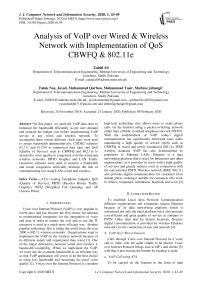Analysis of VoIP over Wired & Wireless Network with Implementation of QoS CBWFQ & 802.11e
Автор: Zahid Ali, Falak Naz, Javed, Muhammad Qurban, Muhammad Yasir, Shehroz Jehangir
Журнал: International Journal of Computer Network and Information Security @ijcnis
Статья в выпуске: 1 vol.12, 2020 года.
Бесплатный доступ
In this paper, we analyzed VoIP data rates to minimize the bandwidth efficiently as per user demand and reduced the budget cost before implementing VoIP service at any wired and wireless network. To accomplish these results different clock rates were used to assign bandwidth administratively, CODEC schemes (G.711 and G.729) to minimized data rates and QoS (Quality of Service) such as CBWFQ and 802.11e to sustain the voice quality in congestion over the wired and wireless networks. PRTG Grapher and LAN Traffic Generator software were used to monitor a bandwidth and create congestion artificially between the link of communicating two setup LANs wired and wireless.
ATA (Analog Telephone Adapter), QoS (Quality of Service), PRTG (Paessler Router Traffic Grapher), WFQ (Weighted Fair Queuing) and AP (Access Point)
Короткий адрес: https://sciup.org/15017014
IDR: 15017014 | DOI: 10.5815/ijcnis.2020.01.05
Текст научной статьи Analysis of VoIP over Wired & Wireless Network with Implementation of QoS CBWFQ & 802.11e
Published Online February 2020 in MECS and Computer Science
-
I. Introduction
Voice over Internet Protocol (VoIP) is very popular in recent days and has become the first choice for national to multinational companies for the integration of voice and data in order to reduce the cost and to use the IT resources is used in a much more efficient way. Another popular technology that is ruling the world since the year 2000 is 802.11 wireless networks. Organizations want to implement the VoIP on the wireless network because of its different nature and requirement than wired [1]. One of the major differences between wired and wireless is bandwidth availability. When we implement the VoIP, we must use the available bandwidth in an efficient way so that VoIP application will prove to be the best choice in using less bandwidth and sustaining the good voice quality [2]. Voices over the Internet Protocol is a modern
high-tech technology that allows users to make phone calls via the Internet using a packet-switching network rather than a Public switched telephone network (PSTN). With the establishment of VoIP, today's digital communication has significantly decreased costs while maintaining a high quality of service (QoS) such as CBWFQ in wired and newly introduced 802.11e IEEE wireless standard. VoIP has also demonstrated its popularity in Ethernet LANs. Ethernet is a data networking platform that is used for businesses and other organizations, as it provides its users with a high quality of services and greatly reduces costs in comparison with the conventional PSTN. Wireless network (IEEE 802.11) also provides digital communication for customers from distant places, making it suitable for customers who work in offices, companies, institutions, hospitals and so on [3].
-
II. Literature Review
To establish Local Area Network Communication different organizations and companies require Ethernet because of its data networking platform which is considered not only the ideal platform but it also presents cost-efficient and great quality of service as compare to PSTN. Other than that for distant locations, distance digital communication is provided by wireless Ethernet networks for the connection of user and network [4].
-
A. VoIP Over Wired Network
Calls through Voice over Internet Protocol be it voice call or video call, are quite simple to be placed. Voice over Internet Protocol brings ease to ISP's and clients [5] with that it also lessens the burden by keeping it aside.
-
a. VoIP Call using ATA
To be carried on the Internet in the form of data packets, analog signals need to be converted in the digital signal which is done through Analog Telephone Adapters. Adapters are connected to the dial-up internet account through built-in modem and PSTN which through internet routes the call to the caller [3].
Standard RJ11 Telephone Jack

RJ45 Ethernet Jack
Fig.1. ATA
As shown in above Fig.1 Analog Telephone Adapters possess RJ-11 jack to be connected on the telephone and second is RJ-45 to be connected on Ethernet. This sort of ATA mostly operates with certain kinds of software.
-
b. VoIP Call using IP Phones
The phone system user of Voice over Internet Protocol merely connects his IP to the closest Local Area Network port. Then the IP-phone as given in Fig.2 automatically enters itself with the VoIP phone system. Numbers are kept the same of IP phones all the time and work precisely similar, regardless of where you connect to your desk or office. A SIP phone based on hardware is similar to an ordinary telephone. These devices have an embedded mini-hub, so you do not need an extra network point for the telephone to share a network link with the computer [6].

Fig.2. IP Phone
-
B. VoIP Over Wireless Network
Mobility is the main reason for the expansion of VoIP technology. The network of wireless Internet Protocol offers its users a wide variety of mobility as well as the specific features of the wireless network. It is a more difficult task for the traffic to be carried in real-time into packets with wireless networks, given that VoIP is a kind of application that works in real-time and is sensitive to the losses of packets due to external interference, coverage limitation and other devices using the similar range of frequency in the networks which are wireless [7]. For deploying VoIP over wireless networks efficiently voice transmission will need some specific requirements. Due to its delay sensitivity and the competition in the transmission of data through similar media as wireless, it results in the degradation of voice quality. It is therefore essential to enforce QoS properly [8] in wireless networks so that voice is given priority over data packets.
-
C. Quality of Service (QoS)
Quality of Service for the Voice over Internet Protocol is defined as a capacity for continuous, clear, and uninterrupted transmission and reception of voices [16]. Due to the four dominant limitations, QoS needs to be implemented:
-
• Guaranteed bandwidth support: Enough
bandwidth is needed to support the traffic of voice and the data in real-time before the occurrence of voice.
-
• Jitter: It is the measurement of variable time to send and receive packets across a network for all network connections as the VOIP network.
-
• Latency: Delay and elapse most of the time is described through the length of time it possesses to reach the listener after being spoken or transmitted by the speaker [9].
-
a. QoS in wired
The primary method of queuing could not solve, neither the leading weighted fair queuing method could solve the problem of the quality of service caused by converged network traffic. If only a voice-enabled network priority is used so that voice is given a priority than data traffic. When WFQ is treated data fairly [10], voice still experiences a delay. All user classifications and queuing mechanisms are time-consuming and complicated to operate on every interface. New queue mechanisms have been developed for combining the best aspects of existing queuing processes.
-
a) Class-Based Weighted Fair Queuing (CBWFQ)
CBWFQ is a system for guaranteeing class bandwidth. WFQ standard expands through the support of class that is user-defined for the traffic. These kinds of classes are identical to the benchmark, including the commands of the Access Control List and the protocols. For each class, a queue is reserved. If class ID is described and matching its requirements, then we can give bandwidth and the maximum packet limit properties of the class. This bandwidth is observed during traffic congestion, and the number of classes is around 64 to deal with service policy.
-
• Classification:
Class maps are distributed through classification. The presence of concern classification choices is based on the version of IOS Cisco. It will depend on the interface format and the encapsulation which uses the service policies.
-
• Architecture:
CBWFQ supports the classification of traffic in its respective FIFO (First in First out) queues in various class maps. CBWFQ classes are treated with a tail drop if a weighted early random detection policy is used for the class to prevent congestion. The default queuing technique is overruled by empowering Class-Based Weighted Fair Queuing on a physical interface as shown in Fig.3.
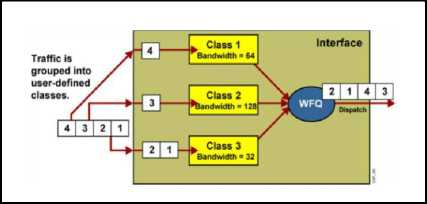
Fig.3. CBWFQ Architecture
network classification, mainly with regard to downstream prioritization compared with upstream traffic flows, which is provided in the fig.4 [13].
-
a) 802.11e
-
802.11e is a suggested improvement to the wireless LAN requirements of 802.11a and 802.11b. It provides QoS functionality including voice, video, and data transmission priority. The standards 802.11e belongs to the 802.11 families of wireless local area networks (WLAN) but It is estimated that 802.11e business [14] and consumer products are widely available in late 2004 or 2005. The LinkSys Access point has capability to add the suggested device by MAC and makes its voice, video or data priority with application of 802.11e.
-
• Scheduling:
CBWFQ provides a weight-allocated bandwidth for traffic classes. Percentage or the bandwidth is computed internally. It solely relies on the kilobits per second bandwidth, percentage of bandwidth and its remaining percentage [11].
Available bandwidth is calculated according to the following formula:
Bandwidthavail = [ Bandwidth ∗ MaxReservable -
SUM ( all fixed guarantees )] (1)
b. QoS in Wireless
Wireless networks have become an essential factor in the latest year that is why Quality of Service participates in services that are wireless in order to offer the best quality of the video, data applications, and voice. Wireless networks can not achieve QoS techniques used in wired networks. There are many more limitation, among the few are:
-
1. Interference: Electric noise and frequency bands of the free variety used by wireless connection makes wireless signal suffer serious disturbance.
-
2. Hidden Node Problem: When it comes to wireless connectivity, where the access point is evident to the node, while it is not evident to some other nodes that communicate with AP.
-
3. Multipath Propagation: Due to diffraction, dispersion, and reflection, the signal might opt for the distinct routes among the receiver and the sender.
-
4. Handoff: It must reset the route possession which starts in wireless networks at the node of mobile [12].
III. Methodology
There are two cases were designed to analyses of voice, and data transmission by sustaining the quality as the voice cannot afford delay in any scenario wired or wireless. Bandwidth is assigned and increased according to needs but we had implemented QoS on both scenarios as discussed above CBWFQ for wired and 802.11e for wireless.
CASE-1 Wired Scenario:
As shown in Fig.5 we had developed two different LANs with IPs of (10.0.0.0 and 20.0.0.0) connected by a single Wide Area Networks (15.0.0.0), ATA worked for the conversion of Analog voice phone call to digital VoIP call, Computers performed netmeting as well as monitored the data rates of each VoIP call routed form LAN1(10.0.0.0) to LAN2(20.0.0.0) by PRTG then created congestion artificially by LAN Traffic Generator and applied QoS for wired as discussed above CBWFQ to sustain the quality as given dedicated bandwidth to voice with first high priority of network.
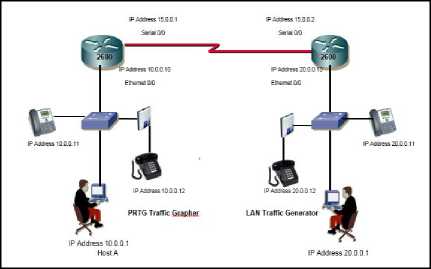
Fig.5. VoIP over Wired Network
Radio

QTVXZtXMXiCO
Client device
downstream

Access point
Ethernet downstream
Wired LAN
Radio upstream
Ethernet upstream
Fig.4. Downstream and Upstream Flow of Traffic
With the increment in load, Quality of Service has prioritized the traffic from Access Point via wireless
CASE-2 Wireless Scenario:
As shown in Fig.6 we had created two different VLANs for wired network separated by two different IPs (10.0.0.0 and 20.0.0.0). Cisco Catalyst Switch was trunked by a single LinkSys Access Point to analyse the data rates of routed call from wired to wireless. With the same AP developed two different SSIDs named as (ESP-
Marketing and ESP Finance) both have diferent IP addresses (10.0.0.0 and 20.0.0.0) similar to wired network collecteively two Local Networks were created with different client’s properties (wired and wireless) to make the comparision easier from wired to wireless call and wireless to wireless call. PRTG and LAN Traffice Generator were used at both ends of clients.
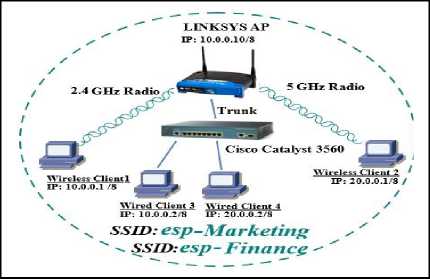
Fig.6. VoIP over a wireless Network
-
IV. Results and Discussion
This section discusses the outcomes on PRTG and LAN Traffic Generator by implementing two scenarios wired and wireless as shown in figure in Fig.5 and Fig.6, the aim is to calculate the bandwidth of voice call, minimize it according to available bandwidth, and regulate the congestion by applying QoS techniques for VoIP.
-
A. VoIP over wired network
Primarily we analyzed the results on PRTG by performing (1-net-meeting + 2 Voice over IP calls) on 125-kilo-bits per second bandwidth shown in the below Figure.7. The outcomes presents that all applications of voice hold 80-kilobits per second bandwidth and by using default codec scheme G.711u shown in Fig.8 in wired network while 30 to 40 kilobits per second bandwidth varies by net-meeting.
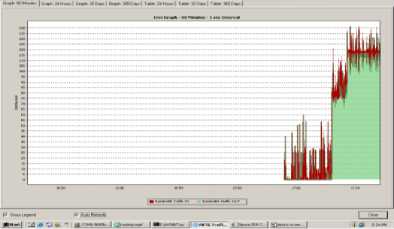
Fig.7. One-Net-meeting + Two VoIP calls on 125Kbps bandwidth
As shown in Fig.9 we changed the codec scheme from default G.711 to G.729 to minimize the bandwidth. It was monitored that VoIP 80 kbps reduced to 20-kilobits per second for each VoIP call mentioned in Fig.10.
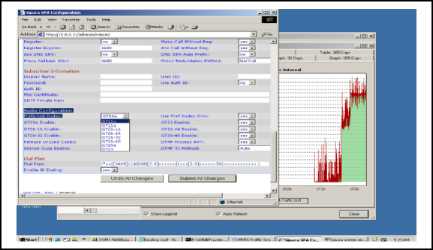
Fig.8. Default Codec scheme G.711u
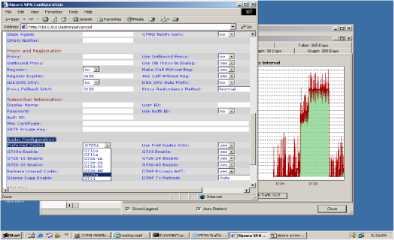
Fig.9. Change Codec scheme G.729
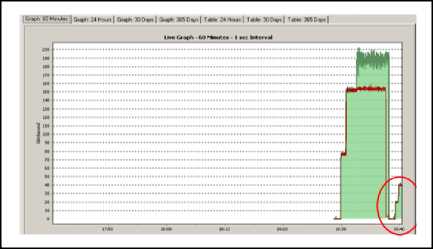
Fig.10. Two-VoIP calls with G.729 Codec
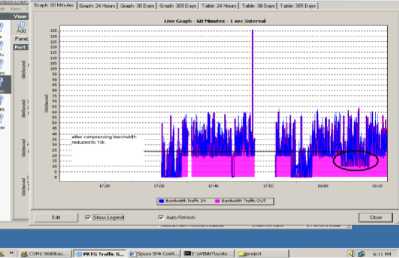
Fig.11. One-VoIP call with TRP Header Compression
-
a. VoIP QoS (CBWFQ) over wired network
In Fig. 12. Bandwidth of 192 kilobits per second was assigned to the DCE end of Cisco Router with that ClassBased Weighted Fair Queuing was done in the similar fashion as was mentioned above in Figure.5. Personal Computers were attached to the ends of the router to operate Local Area Network Traffic Generator. 80 kilobits per second bandwidth was dedicated to voice application in order to implement Class-Based Weighted Fair Queuing.
consume 70 to 80 Kbps bandwidth over wired or wireless network.

Fig.12. One-VoIP with QoS(CBWFQ)

Fig.15. One-VoIP call + Net Meeting
In Fig.12 graph the bandwidth was occupied by another applications as dialing of Voice over IP call 80-kilobits per second bandwidth went down on the first call according to the assigned bandwidth of voice. In a similar way, Fig.13 graph, two times bandwidth reduced by dialing 2 calls 80-kilobits per second to assigned bandwidth for all VoIP calls.
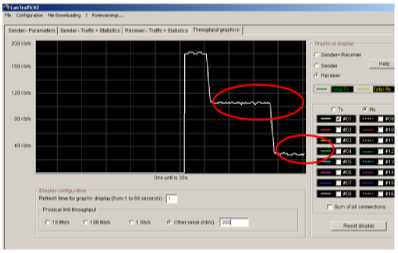
Fig.13. Two-VoIP with QoS(CBWFQ)
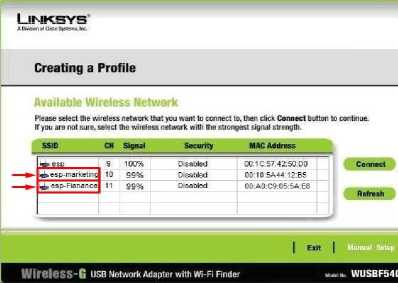
Fig.14. Two SSIDs with LinkSys Acess Point
-
B. VoIP over Wireless
In Fig.14 two SSIDs (ESP-Marketing and ESP-Finance) were created on LinkSys Acess Point according to the wireless diagram given above in Fig.6. As routed the call wirelessly from ESP-marketing client to ESP-finance client the finding were almost same in Fig.15 as found in wired it proves that Voice over IP call always
-
a. VoIP QoS (802.11e) over Wireless.
As mentioned in Figure16. Quality of Service over the wireless network was achieved by Graphical User Interface of LINKSYS router, enabled IEEE standard 802.11e to prioritized the voice application high, device was generally named as ATA added the user MAC address can be seen in the Fig.16. It was examined that if congestion encountered in wireless this ATA device will always get high Voice priority than other traffic.
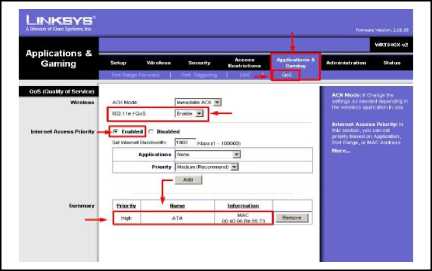
Fig.16. VoIP QoS on wireless
-
V. Conclusion
In this paper calculation, it was explored that VoIP quality is always good in wired owing to the absence of interference, delay and packet loss however the congestion was regulated by QoS (CBWFQ) in case of heavy network traffic. On the other side VoIP over wireless have some problem but it can readily controlled by certain QoS techniques such as given by 802.11e standard, in addition facilities were offered such as easy admittance, mobility, fast and cost-efficient. The consequences states that VoIP is possible over both wired and wireless networks but efficient use of bandwidth can reduce the cost. Clients are preferred to attempt VoIP over wired if the quality is essentials, it can take a longer time to implement and high cost than wireless. If mobility is essential such as in warehouse, universities and hospitals where wiring is typical to connect each user, need simple admittance, low cost and feasibility for smart devices, should offered Voice over Internet Protocol with wireless network that is the base of coming network technologies.
-
VI. Future Work
In this paper analysis we worked on two QoS techniques CBWFQ for wired and 802.11e for wireless users. Furthermore this research can be extended to use newly established QoS methods such as LLQ (Low Latency Queuing) for wired and WMM (Wifi Multimedia) for wireless networks.
Acknowlegement
I would like to thanks to all mighty “Allah” who is most beneficent and most merciful.
Список литературы Analysis of VoIP over Wired & Wireless Network with Implementation of QoS CBWFQ & 802.11e
- C. Jackson, J. Shorter, and K. Forcht, “REPLACING TRADITIONAL TELEPHONY WITH VoIP,” vol. 10, no. 2, 2009.
- H. M. Chong and H. S. Matthews, “Comparative analysis of traditional telephone and Voice-over-Internet Protocol (VoIP) systems,” IEEE Int. Symp. Electron. Environ., pp. 106–111, 2004.
- S. Golhar and V. S. Dhamdhere, “Voice over Internet Protocol (VoIP) Based IP PBX System Design,” Int. J. Sci. Res., vol. 5, no. 2, pp. 1380–1385, 2016.
- N. Chirdchoo, W. Cheunta, K. Saelim, and P. Kovintavewat, “Design and implementation of a VoIP system for campus usage: A case study at NPRU,” 13th Int. Symp. Commun. Inf. Technol. Commun. Inf. Technol. New Life Style Beyond Cloud, Isc. 2013, pp. 216–221, 2013.
- M. Syed and M. N. S. Raza. Dilber, “Comparative analysis of traditional telephone and VoIP systems,” J. Indep. Stud. Res. – Comput., vol. 12, no. 1, pp. 106–111, 2014.
- S. Jalendry and S. Verma, “A Detail Review on Voice over Internet Protocol (VoIP),” Int. J. Eng. Trends Technol., vol. 23, no. 4, pp. 161–166, 2015.
- H. Kazemitabar, S. Ahmed, K. Nisar, A. B. Said, and H. B. Hasbullah, “A survey on voice over IP over wireless LANs,” World Acad. Sci. Eng. Technol., vol. 71, pp. 352–358, 2010.
- A. H. M. Amin, “VoIP Performance Measurement Using QoS Parameters,” Second Int. Conf. Innov. Inf. Technol., pp. 1–10, 2005.
- K. S. Mohamed, “VoIP Techniques and Challenges Karama Said Mohamed School of Engineering , Design and Technology.”
- A. Ramos, “No Title القوقعة,” CWL Publ. Enterp. Inc., Madison, vol. 2004, p. 352, 2004.
- R. B. Bahaweres, A. Fauzi, and M. Alaydrus, “Comparative analysis of LLQ traffic scheduler to FIFO and CBWFQ on IP phone-based applications (VoIP) using Opnet (Riverbed),” Proceeding 2015 1st Int. Conf. Wirel. Telemat. ICWT 2015, no. 2, pp. 1–5, 2016.
- Gregarion Narvaez, “InfoSec Reading Room In tu , A ho ll r igh,” Inf. Secur., 2007.
- N. Khademi and M. Othman, “Guaranteeing per station and per flow fairness of downstream and upstream flows over IEEE 802.11 WLAN,” 2009 Int. Conf. Inf. Multimed. Technol. ICIMT 2009, no. 1, pp. 431–435, 2009.
- R. S. Sherratt and L. P. Gao, “Offering 802.11 MAC frame transport over Multiband OFDM for consumer devices,” Proc. Int. Symp. Consum. Electron. ISCE, pp. 230–233, 2006.

